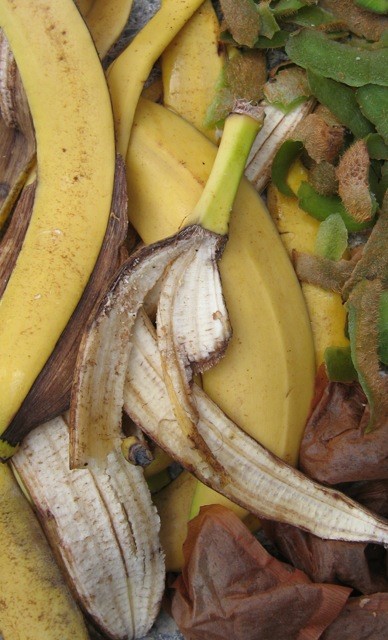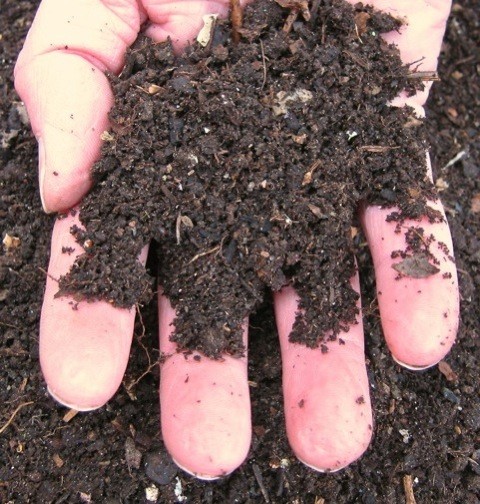If you need to be inspired by the power of composting all over again, just take a look at the figures; the quantity of ‘waste’ that an ordinary bin can divert from landfill is quite remarkable.
I stopped, teetering on the bin’s rim, about to make a terrible, albeit colourful, mistake. The first post-Christmas hoovering here sucked up the usual suspects: shed skin, hairs, sawdust, bits of wayward biscuit, natural fibres from the rugs, and wood ash dust, peppered with turn-of-the-year spruce needles and the odd wizened holly berry. But it also rounded up something else: glitter.

Pretty but perplexing, gets-in-every-nook-and-cranny, seemingly ubiquitous and strictly non-biodegradable, uncompostable glitter. Curse the wily stuff; it slips in on cards, rains silently from envelopes and guarantees not a white, but a multicoloured Christmas – all year round. I do my best to contain it indoors, but there’s no way it’s turning my garden technicolour via a thousand shards of iridescent, polluting plastic. So those first new year hooverings were, reluctantly, banned from entering my compost bin; they were wrapped in paper, and put in the bin destined for landfill and/or incineration (who knows which these days). And yes, I plucked the holly berries out first and scattered them in the wood.
For anyone assuming this is a bit of midwinter curmudgeonliness, hang on. Our world, and especially our marine environments, are awash with microplastic pollution (generally defined as fragments a millimetre or less – often vastly less – in size). We’re pumping out this pollution – which is being found in ecosystems and in organisms big and small everywhere – like there’s no tomorrow. As an earth-respecting gardener – who tries to garden as if the same soil will be here tomorrow – I have no intention of dumping any more pollution into the rhizosphere, no matter how pretty it is. (There’s sparkling news for those who love Christmas and the environment: biodegradable glitter does exist.)
Kaleidoscopic soil crumbs averted, I had to remind myself just what quiet and effort-free powerhouses my ‘cool’ compost bins actually are. All I do is fill them up with a mix of ‘greens’ (think banana skins, apple cores) and ‘browns’ (think cereal packets, kitchen roll tubes), and composting worms, along with myriad other, mostly unseen decomposers, transform them, slowly yet thoroughly, into trickle-through-your-fingers compost. I call this unhurried, cool and no-turning-required technique ‘wormposting’. My bins gobble up anything that’ll rot and are, for me at least, a spirit-lifting antidote to the bloat of excess that blights the tail end of each year. The aura of despair as yet another ‘biscuits for cheese’ packet is scrunched up and dropped into the compost bin, together with some tasteless chocolate, is soon swept away by the promise of soil food and peat-free potting mix to come.

Awed, unfailingly as ever, by the seemingly alchemical powers of my cool, worm-churned recycled plastic bins to turn even old cotton underpants into rich, dark compost, it struck me that I’ve become rather blasé about just how much quiet, steady ‘alchemy’ they perform – and just how much they help assuage my unease in a flagrantly over-packaged world. I tip household greens and browns into them every other day or so, in a roughly equal mix; only a few weeds now and then, or a handful of leafmould, to boost the microbial soup, come from the garden itself (other garden resources are composted separately, as are autumn leaves).
So having cast yet another scrunched ‘seasonal selection’ box into the magic bin, I decided to dabble in something I’m bad at: arithmetic. So as not to frighten my number-phobic brain, I listed those greens and browns that regularly go into my bins, then worked out an average (and conservative) weight for each – a single banana skin, for example, comes in at roughly 75g – and did the sums. Bananas were easy. I eat one a day, every day, so over a year (which is about the time it takes our twoish-person vegetarian household to fill up a bin) I compost 365 skins, which tots up to over 27kg. For relatability’s sake, a bag of sugar weighs 1kg (just over 2lb), meaning that in a year I’ve sent the impressive equivalent of over 27 bags of sugar on their way to becoming rich, homemade compost – all made with steady, sustained effort from the worms, and minimal effort from me; the hardest work is eventually emptying the bin out and sieving its riches. It’s supra-local, requiring not a jot of the fuel which would otherwise be needed to cart its raw ingredients off to a distant local authority recycling/composting site.
Tea leaves and/or teabags put in a good show, too. We add the equivalent of over 23kg (that’s 23 bags of sugar) of leaves/bags to a bin over a year. We compost around 275g of apple cores each week, translating into 14 bags of sugar a year. Among the browns, we scrunch up, on average, one and a half 80g card cereal packets each week; that’s 78 packets in a year, over 6kg of raw material, equal to six bags of sugar. Toilet roll tubes, another brown, come in more modestly at just over 1kg over a year – a single bag per annum. Other regular greens include avocados: three sets of skins/stones a week, giving around 8kg (eight bags) over 12 months. Kiwi fruit skins tot up over a year to 3.5kg, or three and a half bags of sugar.

Impressed? I’m gobsmacked. Now just imagine ten neighbouring households doing something similar, then ten nearby streets, villages, towns… you can see the magic at work. And this is just the tip of the compost mountain, using regular, everyday examples. Cotton tea towels, face flannels and worn-through undies (it’s best to remove the elastic first) are occasional treats. If you’re wondering how I get all those bags of sugar to fit into my bin, I don’t. Once nature’s decomposers and dismantlers get to work, the overall mass of what goes into the bin soon shrinks, and its contents sink. Even a brimful bin, left for three to six months to mature, can lose around a third of its volume before it’s time to unleash its magic on your plot.
Once we fall under composting’s spell, we can begin turning at least some of the spirit-sapping excess and profligacy around us, especially at December’s end, into something positive that grows us better plants and gardens. You can even turn the merriment and good wishes conveyed in your least glossy Christmas cards into future soil food. But remember: it’s the glitter-free ones that your soil will love best.
Text and images © John Walker
Find John on Twitter @earthFgardener


